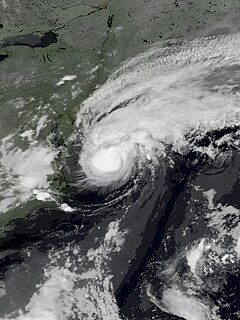
Nova Scotia is one of Canada's three Maritime Provinces, and one of the four provinces that form Atlantic Canada. Its provincial capital is Halifax. Nova Scotia is the second-smallest of Canada's ten provinces, with an area of 55,284 square kilometres (21,300 sq mi), including Cape Breton and another 3,800 coastal islands. As of 2016, the population was 923,598. Nova Scotia is Canada's second-most-densely populated province, after Prince Edward Island, with 17.4 inhabitants per square kilometre (45/sq mi).
The Canadian Hurricane Centre (CHC) is a division of the Meteorological Service of Canada, an agency of Canada's Department of the Environment, that advises Canadians on the threat of tropical cyclones such as hurricanes and tropical storms. Founded in 1987, CHC provides guidance to MSC's weather centres in eastern and Atlantic Canada, and is based in Dartmouth, Nova Scotia. CHC frequently consults with its United States counterpart, the National Hurricane Center in Miami, to coordinate the tracks and positions of storms that pose a threat to Canada.

Hurricane Juan was a significant tropical cyclone that heavily damaged parts of Atlantic Canada in late September 2003. Juan is also the first hurricane name and one of two to be requested to be retired by the Meteorological Service of Canada. It was the tenth named storm and the sixth hurricane of the 2003 Atlantic hurricane season. Juan formed southeast of Bermuda on September 24 from a tropical wave that had tracked across the subtropical Atlantic Ocean. It tracked northward and strengthened over the warm waters of the Gulf Stream, reaching Category 2 strength on the Saffir-Simpson hurricane scale on September 27. The hurricane peaked in intensity with sustained winds of 105 mph (165 km/h) that same day, losing some strength as it raced over cooler waters toward the coast of Nova Scotia. Juan made landfall between Shad Bay and Prospect in the Halifax Regional Municipality early on September 29 as a Category 2 hurricane with winds of 100 mph (160 km/h). Juan retained hurricane strength while crossing Nova Scotia from south to north, though it weakened to a Category 1 storm over Prince Edward Island. It was absorbed by another extratropical low later on September 29 near Anticosti Island in the northern Gulf of Saint Lawrence.

441 Tactical Fighter Squadron was a unit of the Canadian Forces. It was originally formed as a unit of the Royal Canadian Air Force (RCAF) during the Second World War. The squadron operated the McDonnell Douglas CF-18 Hornet fighter jet from CFB Cold Lake in Alberta, Canada. It was deactivated in 2006.

The Shubenacadie River is a river in Nova Scotia, Canada. It has a meander length of approximately 72 km from its source at Shubenacadie Grand Lake to its mouth at the historic seaport village of Maitland on Cobequid Bay, site of the building of the William D. Lawrence, the largest wooden ship ever built in Canada. In 2009, the I Backpack Canada blog named the Shubenacadie one of the top five whitewater rivers in Canada. The lower 30 km of the river is tidal and the river experiences a tidal bore twice daily, with some bores reaching up to 3 m in height at certain points along the river. Local tourism operators offer adventure seekers a chance to ride with the bore on high-horse power Zodiac Hurricanes. Tidal Bore Rafting was invented at the Tidal Bore Rafting Resort by H. Knoll. It is also a popular surfing spot for experienced Sea Kayakers.

Dalem Lake Provincial Park is a provincial park located in the Canadian province of Nova Scotia on Boularderie Island.

Lake Echo is an unincorporated suburban community that is part of the Halifax Regional Municipality in Nova Scotia, Canada; approximately 15 kilometres east of Dartmouth.

Tropical Storm Beryl was the third tropical storm of the 2006 Atlantic hurricane season. Developing from a tropical disturbance on July 18, it tracked generally northward, and strengthened to attain peak winds of 60 mph (95 km/h) under generally favorable conditions. After turning to the northeast, Beryl weakened over cooler waters. On July 21 it struck the island of Nantucket, and shortly thereafter it became extratropical. The extratropical remnants continued northeastward through Nova Scotia, and on July 22 it merged with an approaching cold front.

Stephen McHattie Smith, known professionally as Stephen McHattie, is a Canadian actor.

The 1927 Nova Scotia hurricane was the deadliest Canadian hurricane since at least 1900. The first observed storm of the season, this cyclone developed from a tropical wave over the deep tropics of the Atlantic Ocean on August 18. Initially a tropical storm, it moved west-northwestward and intensified into a Category 1 hurricane on the modern day Saffir–Simpson hurricane wind scale by August 19. The storm deepened significantly over the next few days, and by August 22, it peaked as a Category 3 hurricane with maximum sustained winds of 125 mph (205 km/h). Around that time, the system began curving northwestward and later northward. By August 23, it turned to the north-northeast and then began weakening on August 24. Thereafter, the storm accelerated toward Atlantic Canada. Late on August 24, the hurricane struck near Yarmouth, Nova Scotia, as a Category 2 hurricane, just before becoming extratropical.

Prospect is a Canadian coastal community on the Chebucto Peninsula in Halifax Regional Municipality, Nova Scotia, Canada.

Nova Scotia is a province located in Eastern Canada fronting the Atlantic Ocean. One of the Maritime Provinces, Nova Scotia's geography is complex, despite its relatively small size in comparison to other Canadian provinces.
Digby Neck is a Canadian peninsula extending into the Bay of Fundy in Digby County, Nova Scotia.
Hattie Lake is a lake of Colchester County, in Nova Scotia, Canada.
Hattie Lakes is a lake of Guysborough District, in Nova Scotia, Canada.

Hurricane Beth was a short-lived tropical cyclone which traveled from Florida to Nova Scotia in the middle of August 1971. The second named storm of the 1971 Atlantic hurricane season, Beth's genesis was impeded by a cold environment surrounding the storm. However, as it continued on its northeastward course, it achieved fully tropical characteristics and peaked as a modest Category 1 hurricane on the Saffir–Simpson Hurricane Scale. The cyclone struck Nova Scotia on August 16 before dissipating shortly after. Beth produced substantial precipitation, and the resultant flooding inflicted severe damage to infrastructure and crops.

Nova Scotia lies in the mid-temperate zone and, although the province is almost surrounded by water, the climate is closer to continental rather than maritime. The temperature extremes of the continental climate are moderated by the ocean.
The Halifax Hurricanes are a professional basketball team playing based in Halifax, Nova Scotia. The team competes in the National Basketball League of Canada (NBL) and are a part of the Atlantic Division. The Hurricanes were founded to replace the Halifax Rainmen, who declared bankruptcy in July 2015 ultimately leading to the club folding.














